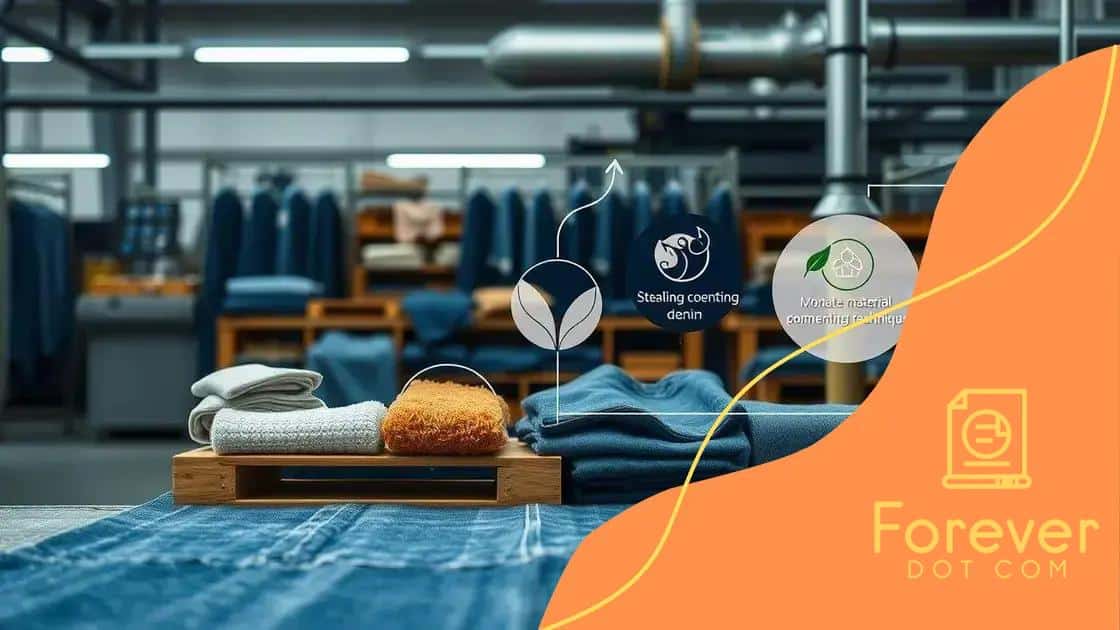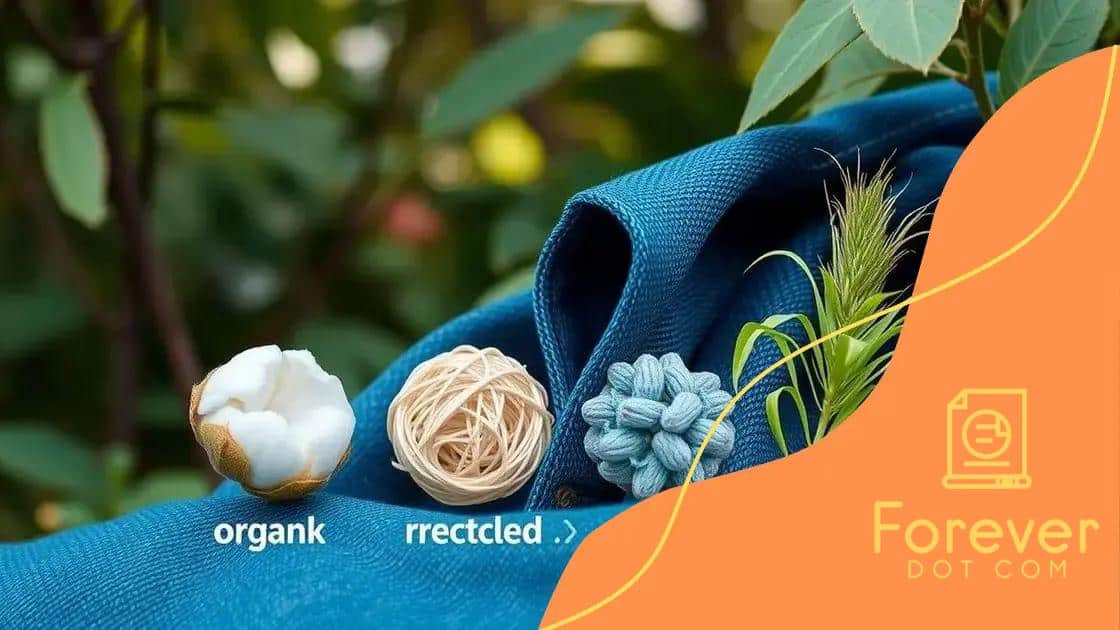The evolution of sustainable denim production

The evolution of sustainable denim production focuses on using eco-friendly materials and innovative technologies to reduce environmental impact while meeting consumer demand for ethical fashion choices.
The evolution of sustainable denim production is changing how we think about fashion. Have you ever wondered how your favorite jeans could be made in a way that’s kinder to the planet? Let’s delve into this fascinating journey.
Understanding sustainable denim
Understanding sustainable denim is essential in today’s fashion landscape. As consumers become more aware of environmental issues, the demand for sustainable practices increases. This shift is prompting brands to explore how denim can be produced with minimal harm to the planet.
To grasp the essence of sustainable denim, let’s examine its key components:
What Makes Denim Sustainable?
Sustainable denim focuses on reducing environmental impact and promoting ethical production methods. It often involves:
- Using organic or recycled materials
- Implementing water-saving technologies
- Reducing harmful chemicals in the dyeing process
As consumers, it’s important to recognize how these elements contribute to a more eco-friendly fashion industry. By choosing sustainable denim, we support environmentally responsible brands.
Key Benefits of Sustainable Denim
Choosing sustainable denim offers various benefits, not just for the environment but also for society:
- Support for ethical labor practices
- Reduction of water pollution
- Decreased carbon footprint
These benefits highlight the importance of making informed choices when purchasing denim. As we learn more about the impacts of our fashion choices, the move towards sustainability becomes increasingly relevant. Investing in sustainable denim is a step towards a more responsible fashion future, benefiting both the planet and the people involved in production.
Key innovations in denim production
Key innovations in denim production are transforming the way jeans are made today. As sustainability becomes a priority, manufacturers are adopting new technologies and methods that minimize environmental impact.
One major innovation is the use of laser technology. This technique allows for intricate designs on denim without using water or chemicals. By replacing traditional processes, lasers can cut, fade, and create patterns efficiently.
Waterless Dyeing Techniques
Another important advancement is the development of waterless dyeing techniques. Traditional dyeing methods waste a lot of water. However, modern innovations have introduced techniques that use minimal to no water.
- Air-dyeing technology reduces water use significantly.
- Digital printing offers precise designs and colors without excess water.
- Recycling water in production processes cuts down overall consumption.
These innovations not only save resources but also lead to cleaner production processes. They help companies meet the growing demand for eco-friendly fashion.
Eco-Friendly Materials
Additionally, another trend is the shift towards eco-friendly materials. Brands are increasingly using organic cotton and recycled fibers. This reduces the environmental burden of denim production.
As the industry evolves, transparency and sustainability are becoming crucial. Consumers are now more informed and are actively seeking brands that implement these innovations.
The push for innovation in garment production has motivated denim companies to rethink their methods. By integrating new technologies and sustainable practices, the future of denim is brighter and more sustainable.
Eco-friendly materials for denim

Eco-friendly materials for denim play a crucial role in making the fashion industry more sustainable. By choosing the right materials, brands can lessen their environmental impact while still producing stylish and desirable products.
One of the most popular eco-friendly options is organic cotton. Unlike conventional cotton, which often requires harmful pesticides and large amounts of water, organic cotton is grown without these chemicals. This not only protects the environment but also improves soil health.
Recycled Fibers
Another innovative material is recycled fiber. Denim made from recycled materials, like plastic bottles or old jeans, reduces waste in landfills. This approach is gaining popularity among sustainable brands.
- Recycled denim may contain up to 20% post-consumer waste.
- Using recycled fibers conserves resources by requiring less energy during production.
- This method helps close the loop in the production cycle.
Consumers are increasingly becoming aware of these materials and their benefits. Adding recycled polyester into denim blends can improve durability while being lightweight. This combination offers both comfort and sustainability.
Other Sustainable Alternatives
Additionally, companies are exploring other eco-friendly materials such as hemp and tencel. Hemp is known for its rapid growth and requires fewer pesticides. Tencel, derived from wood pulp, uses a closed-loop process that recycles water and solvents.
As these materials become more widely adopted, the denim industry can make strides toward a more sustainable future. The shift towards eco-friendly materials reflects a growing commitment to environmental responsibility.
The impact of consumer choices
The impact of consumer choices is significant in the world of sustainable denim. When shoppers decide to buy eco-friendly products, they send a strong message to brands about valuing sustainability. This means that every purchase can lead to positive change.
As consumers become more aware of the environmental effects of their fashion choices, they empower companies to adopt better practices. For example, buying denim made from organic cotton or recycled materials encourages brands to invest in sustainable production methods.
The Power of Buying Green
When people choose sustainable denim, they are not just making a fashion statement. They are supporting a movement that advocates for a healthier planet. Some benefits of choosing sustainable options are:
- Reduced environmental footprints
- Less pollution in water and air
- Support for ethical labor practices
As more consumers demand transparency, companies must adapt. Those that ignore this shift may find it hard to compete. This creates a larger market for sustainable denim and encourages innovation.
Influencing Better Practices
Consumers also influence how brands communicate about their practices. Many now promote their sustainable efforts, like using eco-friendly dyes and reducing water usage. This awareness helps foster a culture of sustainability in fashion.
By spreading the word about sustainable choices, individuals can encourage friends and family to make similar decisions. The collective impact can push brands to enhance their practices and explore new technologies.
Future trends in sustainable fashion
Future trends in sustainable fashion are shaping the way we think about clothing. As more consumers demand eco-friendly options, the industry is evolving rapidly. This change is driven by a growing awareness of environmental issues and a commitment to ethical practices.
One significant trend is the emergence of smart textiles. These materials can monitor our health or adapt to changing weather. Incorporating technology into clothing will make fashion more functional and sustainable.
Sustainable Supply Chains
Another trend is the shift towards transparent supply chains. Consumers want to know where their clothes come from and how they were made. Brands are responding by providing more information about their sourcing and production processes.
- Using ethical raw materials
- Ensuring fair labor practices
- Reducing carbon footprints
This push for transparency encourages brands to implement sustainable practices, paving the way for a more responsible fashion industry.
Circular Fashion
Circular fashion is also gaining traction. This approach focuses on designing products for longevity and recyclability. Instead of following the traditional linear model of take-make-dispose, brands are now exploring ways to keep products in use longer.
This includes offering repair services and encouraging consumers to return old clothes for recycling. Such practices reduce waste and promote a sustainable consumption model, which is beneficial for the environment.
As these trends develop, it’s clear that the future of fashion is not only about style but also about sustainability. The integration of innovative and eco-friendly practices will redefine the fashion landscape.
FAQ – Frequently Asked Questions about Sustainable Denim Production
What is sustainable denim?
Sustainable denim is a type of jeans produced using eco-friendly materials and methods that reduce environmental impact.
How can my clothing choices affect the environment?
Your choices impact the environment by influencing brands to adopt sustainable practices and reduce waste in the fashion industry.
What are some eco-friendly materials used in denim?
Common eco-friendly materials include organic cotton, recycled fibers, and natural dyes.
What trends are shaping the future of sustainable fashion?
Future trends include smart textiles, transparent supply chains, and circular fashion approaches that emphasize recycling and durability.






